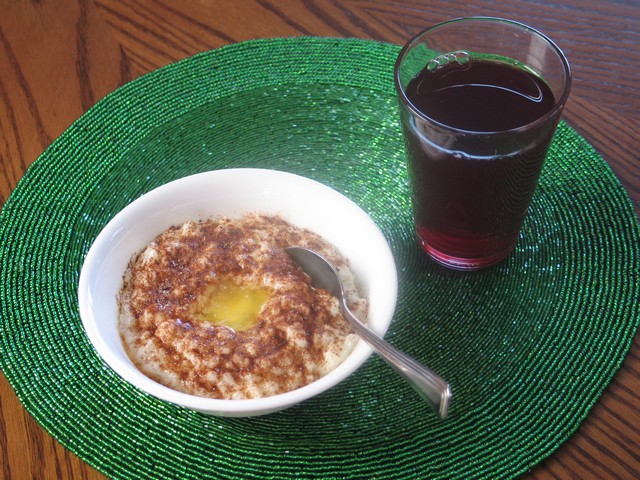
A Christmas tradition in countless Norwegian homes is to prepare Risengrynsgrøt, or rice porridge, for lunch during the day of Christmas Eve. White rice is cooked in milk for nearly an hour until tender and thick, then salt and sometimes sugar and vanilla is added. Often shortened to say simply “risgrøt”, this porridge is traditionally topped with sugar and cinnamon, and a dab of butter in the center. Often times red juice is served to drink with this meal. This rice porridge is also served throughout the year in Norway, often as a warm, comforting Saturday lunch.
One important reason to prepare this porridge during the day of Christmas Eve is that the leftovers are used to make a traditional dessert commonly served after dinner. This desserts is called “Riskrem”, or Rice Pudding, in which whipped cream is added to the porridge. The mildly sweetened fluffy dessert is topped with a red berry sauce. A single blanched almond has been hidden inside, and whoever finds it in a mouthful gets a small prize! Riskrem is soft and light tasting and nicely balanced with the berry sauce on top, and mostly served only for Christmas and New Year’s. Here is a link to this delicious dessert!
If you do try any of my recipes, I would really appreciate a quick comment with a star rating (option found immediately under each recipe). It helps me out tremendously! Thanks in advance!
In this post I will give you the the standard, traditional recipe and use pictures to show you how to make risgrøt. Otherwise, if you’d like a more hands-off approach and explore other cooking options, such as using an oven, cooler, slow cooker, or even pressure cooker to prepare risengrynsgrøt, click this link and I’ll show you what you need to know.
In the following picture you’ll see most of the ingredients needed for risengrynsgrøt: water, rice, whole milk, salt, vanilla sugar, and in addition I usually add some white sugar, which I forgot to add when I took the picture. But you all know what sugar looks like, so I trust you’ll be just fine.
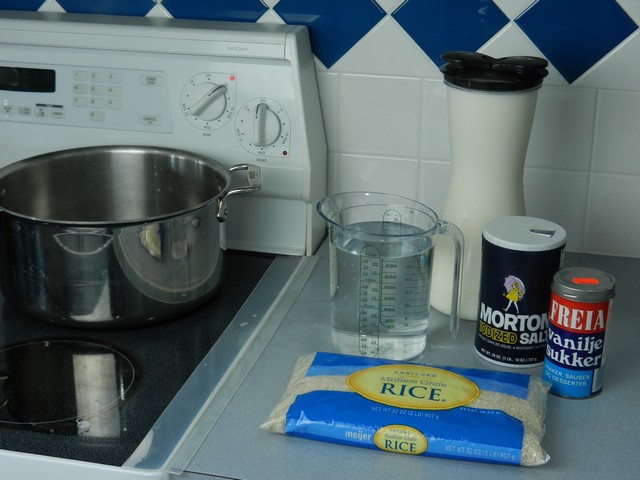
The best rice to use for this recipe is white medium grain rice, not the standard long grain. It is not impossible to use long grain rice, but the result will not be as creamy and nice. In the picture below you can see the difference between these two grains:
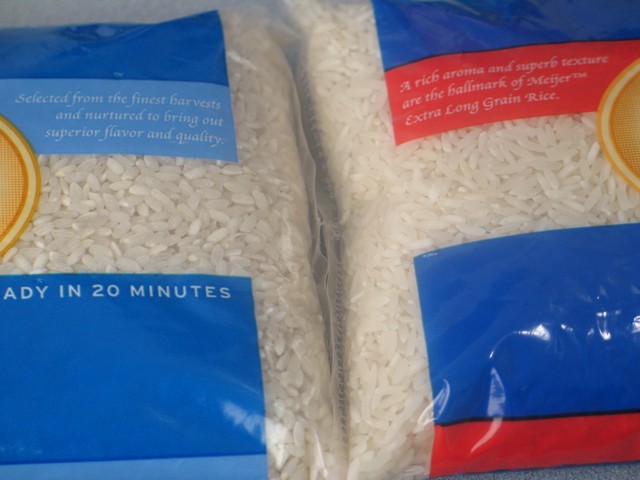
The bag to the left is medium grain, and on the right is regular long grain. Medium grain has a rounder shape and works well in creamy dishes such as risgrøt and risotto, as it tend to be stickier and cling together better. You can also use a short grain rice such as sushi rice or risotto rice, which is even rounder and larger than medium grain and produces an almost luxurious result. But these types can be very expensive. For risgrøt you’ll only need an off-brand medium white rice if you can find it, unless it is Christmas and you want to splurge!
Moving right along:
Using a pot with a heavy bottom is important, as milk tends to burn easily if the bottom is thin. Since this porridge will cook for an hour, a heavy pot is needed. I have found that my Cook’s Standard pot works wonderfully for this use and is just as good of a pot as my All-Clad (seen in the picture below), but not nearly as expensive.
Start out by boiling 1 part rice to 2 parts water on medium low heat, uncovered, until most of the water has absorbed. Stir now and again. This will take approximately 10 minutes. I like to stir with a flat turner as I find it easier to scrape the whole bottom of the pot, preventing sticking and burning (especially after milk is added.)
You can use a lid if you want, but leave it on a crack so that some steam can escape. You may need slightly less milk if you use a lid. I seem to remember my mother keeping her wooden spoon inside the pot while cooking, which kept the lid on a crack.
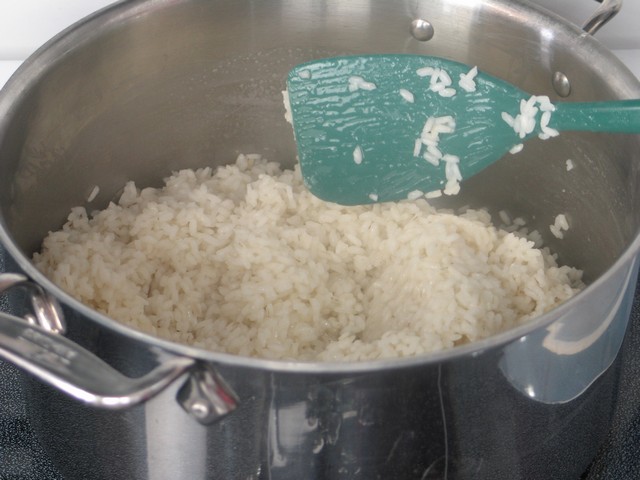
Add milk little by little, about a cup or two at a time. Stir well, then simmer on low heat, uncovered. This is how it’s traditionally done; however, I sometimes pour all of the milk into the pot in one sitting and stir while bringing up the temperature again. Then obviously lower the heat once it’s back to a simmer. Milk burns easily though, so I have to pay attention and stir a lot when doing it this way.
I doubled the recipe below, as I wanted plenty of leftovers for a good amount of Riskrem dessert. So my pot may seem more filled than yours if you follow the amounts suggested in the recipe.
Definitely use whole milk for this recipe, or at the very least use 2%. Whole milk works better as it leaves the porridge creamier and tastier, but it also helps to keep it from burning. Low fat milk burns more easily.
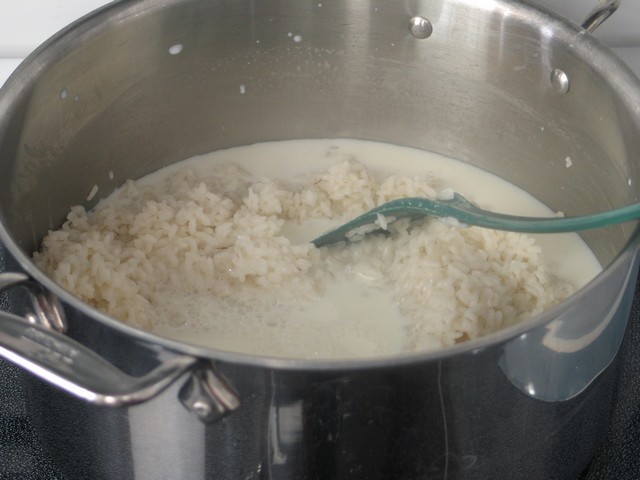
Let simmer over low heat until thickened, stirring well every 5 minutes or so to prevent milk from sticking to the bottom and burning. Every time you see that a lot of the milk has absorbed, keep adding more. The amount you add each time is not too important, unless you add so much that it stops boiling entirely. Then you may have to bump up the heat temporarily while stirring and paying close attention so it doesn’t burn. Cook on as low heat as possible while still seeing it bubbling gently as it simmers. Just barely bubbling, no more, to prevent burning. Toward the end, as it really thickens, it will burn more easily, so don’t forget to check.
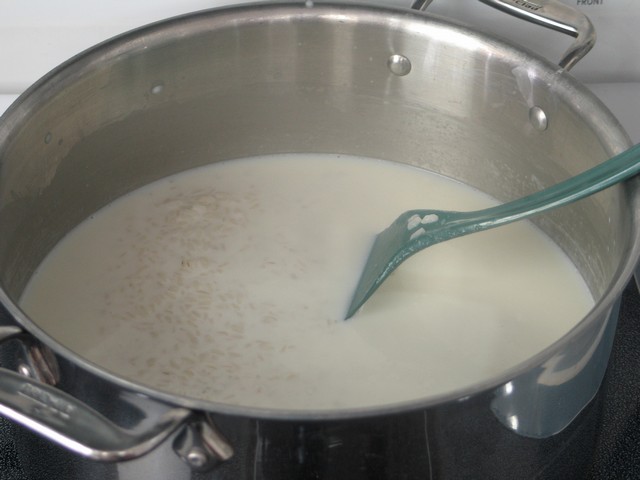
Keep adding milk until rice is tender and the risgrøt is thick and creamy. The amount of milk needed will depend on how thick and tender you want the rice and porridge to be. You may use more or less; like most Norwegians, I actually never even measure the milk, I just keep adding more until it has reached the consistency we like. All in all the cooking time will be around an hour from beginning to end.
It may seem like a daunting task to be waiting a whole hour while stirring so frequently. Personally I set the timer so I won’t forget, then I go about cleaning up the kitchen or a different activity close by where I can hear the timer, and the time goes by pretty quickly. It’s not a big job: Simmer, add more milk, stir every so often. That’s about it.
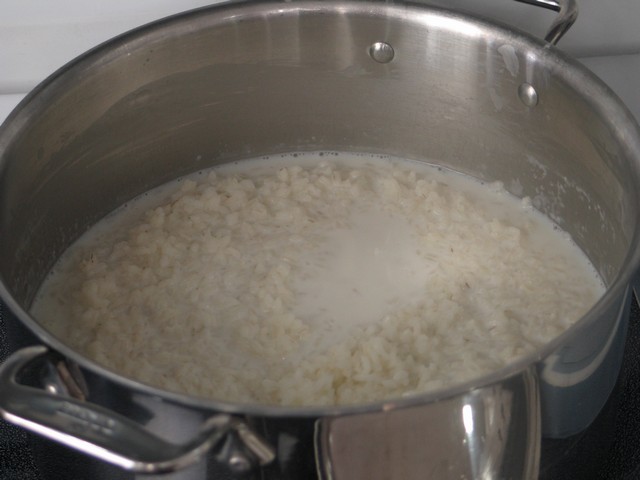
Next picture: Not quite thick enough yet. If the rice is not completely tender, add more milk and continue to simmer.
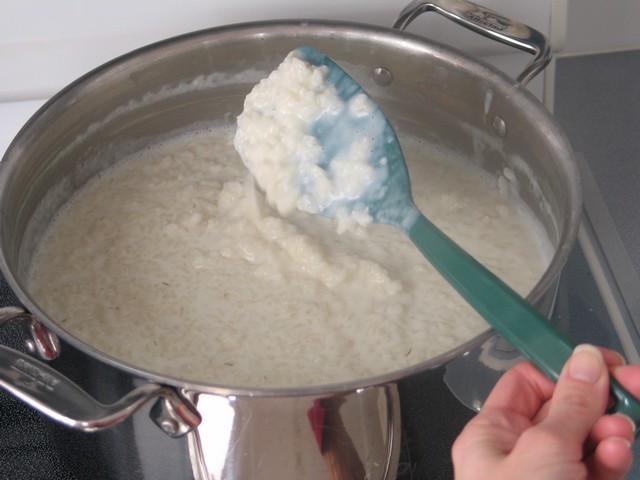
In the following picture, the risengrynsgrøt is thick and the rice nicely tender. It is now done cooking! Add salt, sugar, vanilla powder, stir well and serve immediately while still hot. If it sits for a while after it’s finished cooking, the risgrøt will continue to thicken. If so, you can add some more milk before eating to thin it a little.
If you don’t have access to vanilla sugar (vanilla powder), vanilla extract may be used instead (but use only 1/3 of the amount since it’s much stronger!) Just keep in mind that vanilla extract will add an ivory tint to the porridge, so if you are at all able to get a hold of vanilla sugar it will make for a whiter and prettier porridge. Personally I shop for extras whenever I am in Norway, and other European countries will have it as well. Otherwise I have found it in supermarkets here in the US in the international shelves and in some specialty stores. Even AMAZON carries it! Just check out this link!
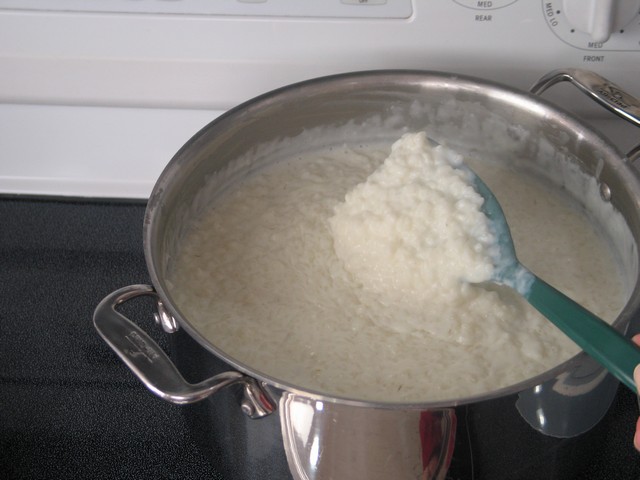
During Christmas, I double the recipe and reserve 4 cups to put in the refrigerator for our traditional Norwegian Riskrem dessert. Otherwise we just eat and finish the leftovers little by little during the next few days.
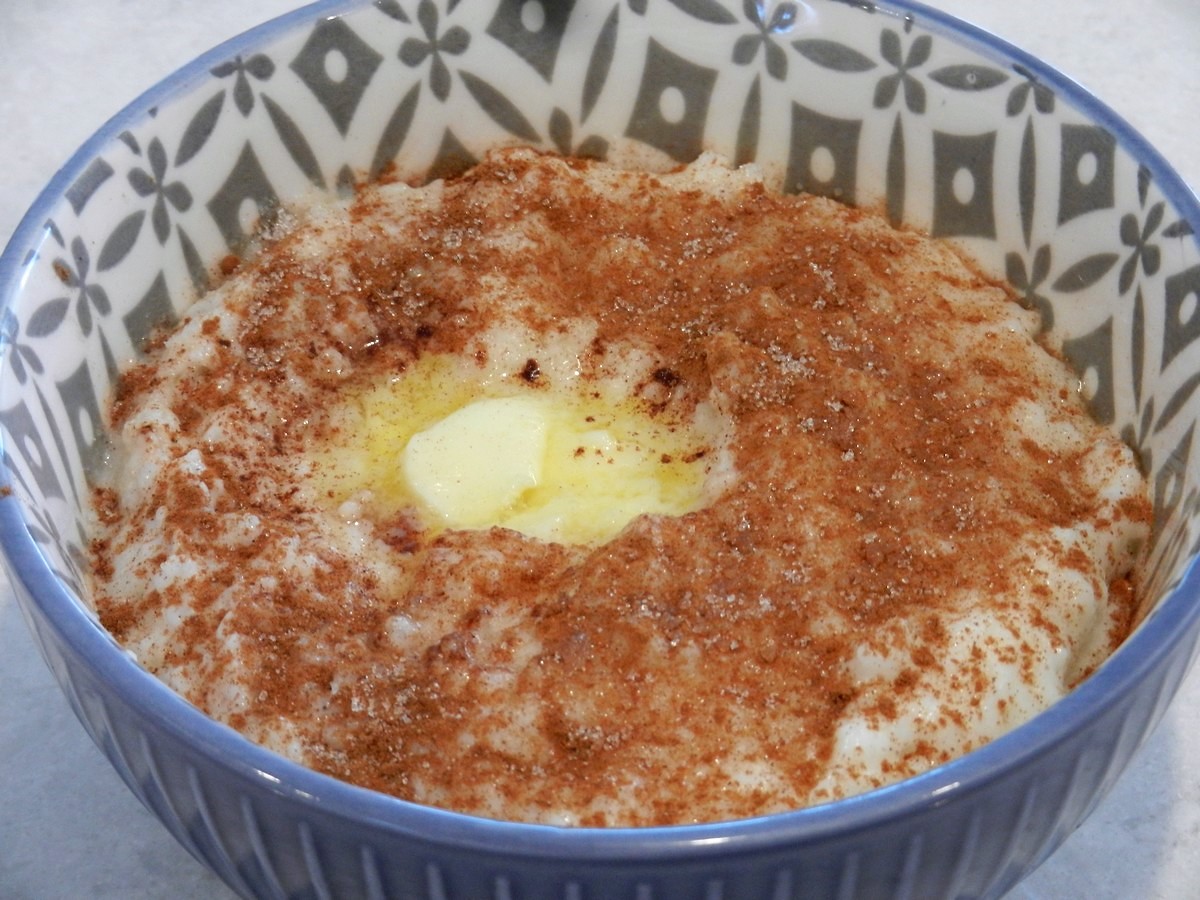
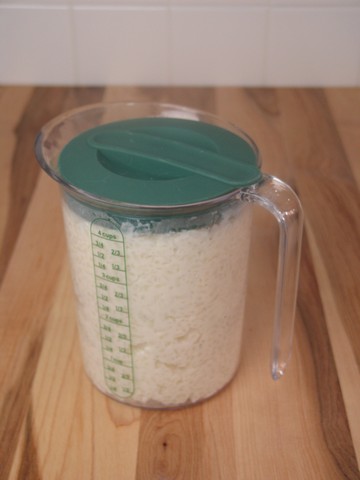
Risengrynsgrøt, or Rice Porridge, is traditionally served in bowls with cinnamon and sugar sprinkled on top, and a dab of butter in the center. Red juice is usually served as well. This authentic Norwegian recipe makes for a perfect Saturday lunch! If you decide to try this recipe, please consider leaving me a comment and star rating below as it is very helpful for me as a blogger. Thank you!!
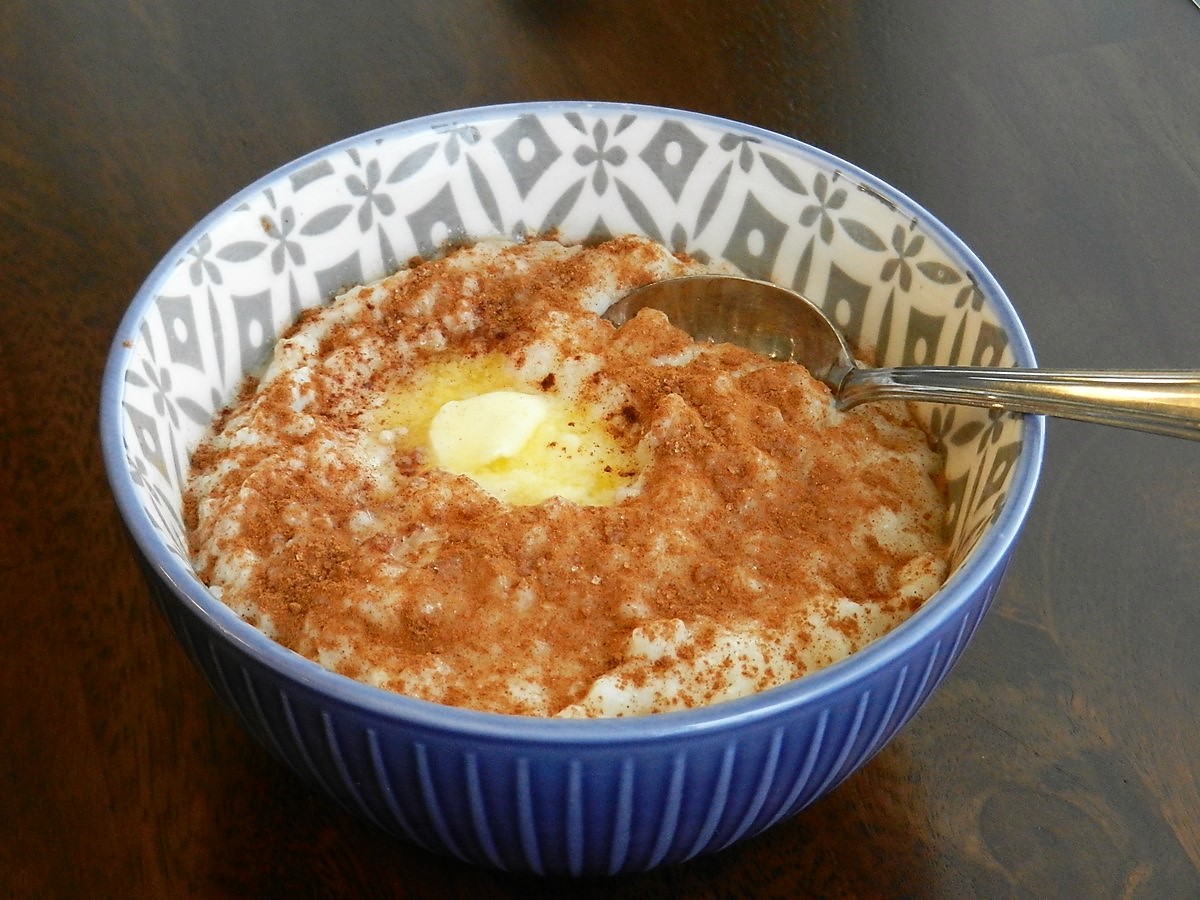

- 1½ cups white medium grain rice, or risotto rice
- 3 cups water
- 5 cups whole milk
- 2 tablespoons white granular sugar
- 1¼ teaspoons salt
- 2 teaspoons vanilla sugar (preferred), or ¾ teaspoon vanilla extract
- Let rice and water simmer on medium low heat in a heavy pot, uncovered, until most of the water is absorbed. Stir occasionally. This will take approximately 10 minutes.
- Add a bit of milk (approximately ¼ or ⅓ of the total milk needed), continuing to add more over the next 45-50 minutes while simmering on low heat. Stir well every five minutes or so. (An alternative is to add all of the milk right away, then stirring almost constantly as you raise the heat a bit to let it come to a simmer. Then lower the heat again to keep at a simmer.)
- Add more milk whenever the porridge thickens as the milk absorbs until rice is nicely tender and porridge is thick and creamy.
- Add sugar, salt, and vanilla sugar; stir well and serve while hot. If vanilla sugar is not available, you may use vanilla extract; however, this brown liquid will change the color of the porridge and it will not be as white as it should be.
- If the porridge becomes too thick, add more milk to thin it.
- Serve in bowls and sprinkle with cinnamon and white sugar, and a dab of butter in the center. Serve red juice to drink with the meal.
- Leave leftovers in the refrigerator and thin with milk when reheating.


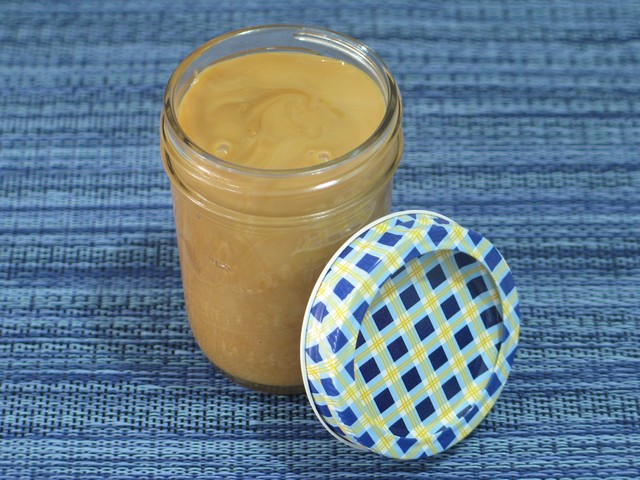
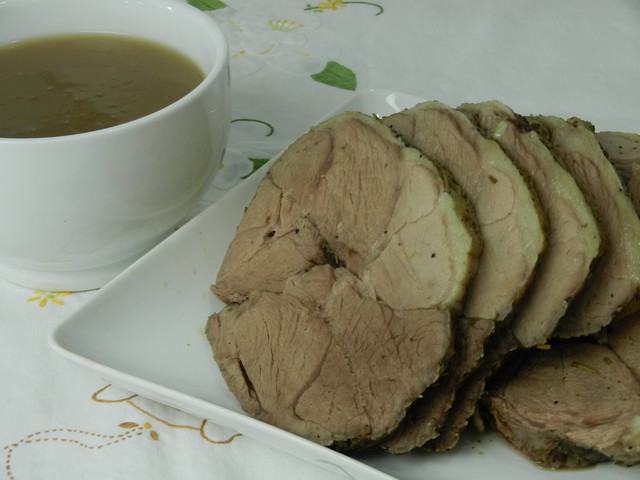
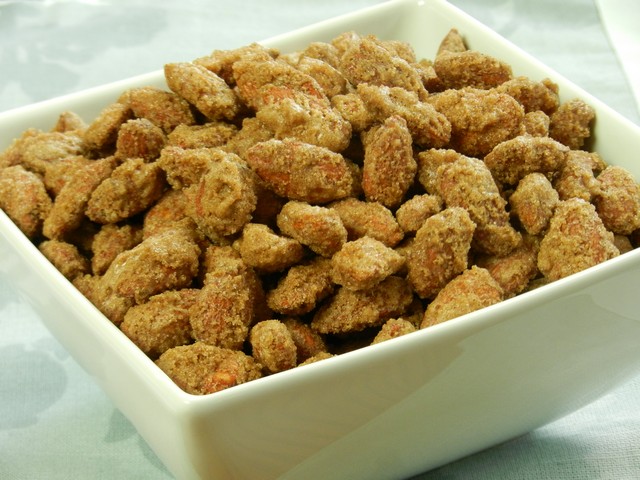

I’m going to try this, Therese! Sounds good.
How fun! I hope you’ll like it!
I already ate porridge, but that I can remember my host mom (I was an exchange student in Norway) told me that you can’t stop stirring, then, when it reaches the way that you want you just need to keep stirring until the rice is good enough. Or, you can put it in the oven and leave it there for almost one hour
-3
If the pot you’re using has a thin bottom, then it can be necessary to stir the whole time. If you use one that is more heavy duty, there really should not be a need to stir all the time. Most people would not have time for that anyway, and with a proper pot, they usually have great success stirring only every few minutes. I usually let it go 5-10 minutes between stirring the first half of cooking time, depending on the heat setting as well, then toward the end, when it thickens up, I find it necessary to stir more often. Lower heat though, less stirring.
what temp to you set oven to and does it stick. how do they prepare it. thanks
I’ve never made it in the oven, but I decided to do a search of Norwegian recipes. And I found a suggestion regarding making risgrøt in the oven:
Preheat oven to 225 degrees Fahrenheit. Prepare the first steps on the stove top until the milk has been added and come to a simmer. Then put a lid on the pot, place in the oven, and let sit for about one hour.
Hope that helps!
I now have tried making it in the oven, and it worked very well. After talking to my brother who still lives in Norway, I followed the directions above for first cooking with water, then adding all of the milk, and brought it to a simmer. Then I put the pot into the oven with the lid on and turned it on 250 degrees, then turned the oven off and let it sit for a good hour. It was perfect!!
After our family grew my husband and I realized that we could no longer just by risen grot in the store packages and bring them to the states. My husband who grew up in Oslo experimented with Aborio rise and our family could enjoy risen grot. However my husband who travels a lot wasn’t always around to prepare it and it is a Saturday night tradition in our American Norwegian household. It was wonderful to find your recipe and more importantly your step by step instruction, much more detailed and thorough than he has ever been. Thank you so much ?
I’m glad you liked my post! Hopefully this will provide a way for you to easily and inexpensively make it yourself! Happy cooking!
My day was Norwegian and my mom learned from his mom. We always used a double boiler, only milk or even half and half plus raisins (I like a lot of them but mom only liken a few lol). Instead of cinnamon we used sugar, butter, and nutmeg just in our own bowl so we could add to taste. Did that make it not really traditional? I added my email but don’t have a way to access it right now.
Hi Susan,
The way you like to make it is not really traditional, but then again, so much has changed in Norway the last three or more decades, and food from all over the world has been introduced. Norwegians are very open to new foods, and in fact embrace “new and different”. So there is nothing wrong with changing it up or making it your own way. Happy cooking!
My grandmother made what she called “Rice Pudding” (she was Swedish and my grandfather was Norwegian). Her recipe is very similar to this but she cooked the rice with water, sugar, salt and butter; then when it was done she added milk, eggs and vanilla and poured into a 9×13″ pan, sprinkle with cinnamon, bake until set, and then she always served it cold with whipped cream.
I’ve never seen it served that way before, but I’m sure it was delicious! Thanks for sharing!
My grandmother used to make this for me. I went once a week to set her hair and always got this at least once a month. Love the stuff. Thanks for sharing your recipe.
Thank you for posting this recipe. My sister-in-law made this & brought it to our Luciadagen potluck. It was so good! I asked for the recipe & she sent me to your site. I’m definitely making this right away. Delicious!!
Wonderful!!! So fun to hear!
What is the serving size? I am wanting to bring it to my school for the children.
It serves 5-6 people.
will it work with long grain rice?
Yes, long grain will work, but not as well as a shorter, rounder type of rice. But I have done it in a pinch.
I’m going to try to make this for my daughter who is doing a little breakfast potluck around “Nordic” dishes. Wondering–if I were to make this ahead of time (evening before a morning event) should I keep it warm overnight in a crock pot or refrigerate it and heat it In the morning?
Thnx!
Definitely refrigerate and reheat the following morning. You may need to add a bit of extra milk as it will thicken further as it sits. I would NOT keep it warm overnight as the grains will continue to expand and get overly mushy, like how pasta would. And it would get awfully thick, too. Refrigeration works very, very well. 🙂 Hope it turns out wonderfully!
Have you ever made it in a rice cooker?
No, I have not. I’m not familiar with how they work, so I don’t know if this recipe will work in a rice cooker. If anyone tries it, please let us know how it works out!
I was interested I reading about the rice pudding. My Grandfather immigrated from Norway in 1867 as a young boy. He remembered a lot of traditional dishes including the rice pudding. He always called it yulegrot ,so I had some trouble finding the correct recipe, due to spelling and pronunciation. .I love the pudding and make it often, not waiting for Christmas . Yum ! Thanks for letting me share.
Yes, people sometimes do call it julegrøt when serving it for Christmas. This expression translates to Christmas porridge. 🙂 Thank you for your comment, it was fun to read about your background and how you like to eat it year round! Sorry you had trouble finding the correct type of recipe, but glad you ended up here on my site in the end! God Jul, Merry Christmas!
Thank you! My grandmother passed away this year. She immigrated to the US from Norway after WWII. She made Riskreme every Christmas Eve. This recipe turned out great! Can’t wait to move on to step two tomorrow. She would be so proud.
I’m sorry for your loss! I’m so glad to hear this recipe worked out well for you! I’m sure she indeed would have been proud and happy to see you continuing these traditions! 🙂 Thank you for your comment, and Merry Christmas to you and your family!
I wish I knew my grandmother’s recipe for Risengrot. I remember that she used to put out a quart or a pint of scalded heavy cream in a bowl to sour for 4 days. Then, just before serving the “grot” was ready to be served, she would add a teaspoon or so of lemon juice and again boil and stir it. It would separate into a yellowish buttery-looking clear fluid on the top and rue or something (whey?) on the bottom. The bottom part would be added to the risengrot and the clear yellow would be dabbed on the middle of each serving in a little pool instead of butter. Years ago, my mother and I tried to do it this way, but something has changed in the way heavy cream is processed and this process just didn’t work — it wouldn’t separate and it tasted bitter. So in more recent years, I have just used sour cream from the store. Anyone else use sour cream?
That’s interesting! I’ve never heard of doing this for risengrøt. Lemon can be used to separate milk during cheese making, so you would then end up with whey and curds. But I’m not sure what happens when separating cream, since cream is primarily fat, and also when culturing it first like your grandmother did. I sure would have liked to talk with her and ask her about it! 🙂 Thank you for sharing, I enjoyed reading your comment!
Thinking more about it, there is another recipe (Norwegian) in which you simmer sour cream and a couple of other ingredients to make a very nice, smooth, rich porridge called sour cream porridge. During the process, yellow liquid that looks like butter will start to pool on top, and we would then skim that fat off to use when serving. It sounds like your grandmother used some steps from this recipe and combined it with risengrøt. She obviously first made homemade sour cream, and then separated it to get the yellow fat out of it. I’m sure it tasted very good!
My grandmother’s called that pudding Rommegrot. The heavy cream and some flour were cooked and stirred constantly and the butter skimmed off as it separated from the cream. Then the reserved butter was spooned over each dish of pudding along with cinnamon sugar sprinkled on top. Rommegrot has been a Christmas staple in our family for years now. We called the risengrynsgrot “rice mush” and grandma served it for supper a couple times a month.
How fun that you took the time to describe rømmegrøt!! I remember it very well, and just as you described it. My mother would make it once in a great while when I grew up. I tried it once as an adult and I wasn’t able to get it quite right as there was no butter coming out of it to skim off. I’m really not sure why, and I didn’t have my mother there to show me. It really is becoming a bit of a lost art among the younger generation in Norway since it is a difficult dish to make. These days you can buy it ready made in coolers at the store, and that’s what many end up doing. May I ask which brand sour cream you use? I am convinced it has to be a pure and whole product to work. Do you agree?
By the way — I find that rice for risotto works best. My grandmother insisted on Carolina rice.
We have a Norwegian exchange student staying with us, made this today for Christmas lunch, was very close to what her family makes, thank you.
You’re welcome! How nice of you to make something special for her to remind her of home!
My aunt used to make what my Norwegian uncle referred to as Groet. He pronounced it as “grurt ” with a short ur. . It may have been because cream was not readily available in Sydney in the 1940s but she made it on milk, and rice flour. I really loved it with cinnamon and sugar.
That is very well explained on pronunciation! Very nice job! I can see how it can be made on rice flour. I wonder if the consistency is similar to cream of wheat? I’m sure it was tasty! Thanks for sharing!
The end result is exactly like what I grew up eating and still do. Arroz con leche, my mom would make it on chilly evenings or cold mornings. Now I’ll have to make it to prepare that amazing dessert you make with cream and red sauce! Yum!
Wonderful! And I hope you love riskrem as well! Thank you for commenting!
we use only one cup of rice and let it cook with the milk all day. I dont use any water and end up using a whole gallon of milk. My kids like to sweeten it with red cookie sprinkles 🙂
Thank you for your comment! The reason Norwegians cook risgrøt with water first, is to save on milk (which is expensive in Norway) and to speed up cooking time. The water used in the beginning absorbs quickly into the rice to kick start the softening process, and since it’s hidden inside the rice, it doesn’t affect the flavor at the end. Cooking it this way saves you money by using less milk, and it’s done in an hour.
I’m glad you’ve found a way that works for you, however, maybe someday you’ll try the above recipe, which is how risgrøt is traditionally made and the way Norwegians love it. If so, I hope you’ll come back and give me a rating based on how you like it done this way. Thanks again for your comment! 🙂
Well said and with such diplomacy too!
Thank you very much Emma, I really appreciate the support and your kind rating! Much love to you!!
My aunt Martha made this every year.my favorite. I am so happy, because my sister wanted it. Now we can enjoy it.thank you. My dad dad was born in kristiansand norway. I have been there to visit my family. It is the cleanest place I have ever seen.
I’m glad you found this recipe, and hope you’ll enjoy it for years to come! Kristiansand is a beautiful city and surrounding area! I grew up just a few hours north of there.
Last year at this time I was in Bergen Norway.(My mother is 100% Norwegian. Her grandparents all emigrated from near Oslo.) I loved the rice pudding and am anxious to try your recipe. Our family never made it. We do make lefsa and fruit soup though. Will let you know how it turns out.
How exciting! Bergen sure is a beautiful city with the mountains all around you and such charming houses by the ocean, cute little streets etc. I hope you enjoyed your stay! I hope you’ll enjoy this recipe for years to come!
Perfect!! I just tried this in Fosnavåg, Norway a few weeks ago and have been searching for the perfect recipe. This is it!! Thank you!!
How nice to hear! Wonderful! Thank you for your comment!
My Mother made this for us when we were sick, instead of oatmeal for breakfast, and not just for Christmas. I still love it and it is the one thing I can eat when I have been ill.
What sweet memories, thank you for sharing!
Hmm … the ingredient that seems to be ‘missing’, for me … is nutmeg … whether as the breakfast porridge, or in the ‘leftover’ dessert mode (folding in sweetened whipped cream), I always associate the flavour of nutmeg, with any Scandinavian milk-based food … in fact, more so than cinnamon … and, while I agree the extract will give the porridge/pudding a slightly ‘brown-tinged’ colour, I cannot imagine using an artificial vanilla flavouring, as found in Vanilla Sugar, to any dish … I did more often make rice pudding, when I had more than just myself for whom to cook … but I might just have to start trying to make smaller batches, just for me. (My Norwegian friend, who first ‘taught’ me to make Scandinavian style rice pudding, always recommended Carolina brand medium grain rice … ) I’ve not made this in such a long time … but just the other day, I was craving it so that I bought ‘Kozy Shack’ rice pudding … two containers, one plain, one with raisins and cinnamon … and yup, ate it – but was sorely disappointed … sigh. So, I think I’m going to pull out the Dutch Oven, and make some at the end of this week …
Well, the use of nutmeg for traditional risgrøt or riskrem is not common in Norway. I think you have to take into consideration that many changes will be made when a traditional food is brought to another country, so that may be why you associate these dishes with nutmeg. However, in all the years I lived in the country of Norway, I never even heard of anyone adding nutmeg to risgrøt or riskrem, let alone tasted it. And I had it served a lot of places! 🙂 Cinnamon was always the spice of choice for risgrøt, never nutmeg. So for true, TRADITIONAL risgrøt or riskrem, nutmeg does not actually belong, although it sounds like it would be tasty! 🙂
As for vanilla extract, I definitely agree with you that pure extract will always be superior to artificial vanilla products such as vanilla sugar. However, still back to when I grew up (and even now), in Norwegian traditional recipes vanilla sugar was always the chosen ingredient for the simple reason that this is what was available to us and what we could afford. Vanilla extract would have been considered a specialty product and not something people would normally purchase, although times are changing and people can better afford it now and it is more available. I hope this helps explain! 🙂
Visited a Swiss Historical Village in New Glars, Wi. There was on display was an “ivare”. The little description said it was cut from the top of a spruce tree which generally had five small branches. The ivare was used to make a Norwegian porridge dish. Could not find any info on it. Do any of you know anything about this? It was Quite interesting.
Sorry, I have never heard about that. It could possibly be correct, but definitely not common. There are definitely some traditions that are local to specific areas only though, and this might be one of them. I wish I could be of better help!
Hi! I don’t know about the name, ivare, but in many museums and kitchens in Norway, you can surely see what Glenda is talking about. I think it was used as a rustic whip – a long stem/handle on top (the top of the tree) and then 5 short branches coming off of it about a foot down…. the branches angle up slightly and have been trimmed to 2-3″. It has been peeled of the bark, of course, and generally hangs from a cupboard or hook somewhere in the kitchen. You twirl it between your hands to agitate/mix liquids. Quite ingenious! I love how they made everything they needed in the old days – usually from wood. Thank you for the risengrot and krem recipes, too – I’m planning to make a big batch for our Daughters of Norway Christmas meeting this year! I’ve enjoyed reading all of this. Tusen takk!
Værsågod, bare hyggelig! How interesting to hear about this kitchen tool, thank you for sharing with us! Yes, they sure were resourceful back then, found a use for just about anything and made whatever they needed. Children were creative as well.
This is a lot like the family recipe I have used for years. But I use a double boiler, so it doesn’t stick as much. Also I add a beaten egg the last 10 min of cooking. We make it every Christmas eve.
Sounds delicious, and interesting that you can make it in a double boiler! Thank you for the idea! Would you mind describing how you prepare it in a double boiler? Thanks in advance!
I married into a Norwegian Family most of the Women folk have passed away and took the recipes with them and my wife never learned and her Dad and Uncles were missing everything from lefse to risgrøt so Being the main Cook in the Family your Recipe has made 70+ year old Men Happy campers they are now Expecting Riskrem lol
so now to teach the Wife the recipes
Thank You
Oh how awesome!! That just makes my day! You’ll have to tell them God Jul (Merry Christmas) from me! Thank you so much for posting this comment, I love it!
Excellent recipe and information on this classic Norwegian rice pudding. What would a red juice be?
Thank you.
Let me try to clarify: Red juice is called “saft” in Norway, so this recipe uses rød saft. Even though the word “juice” is used only for orange juice in Norway, in the US “juice” can be from all kinds of fruits and berries and is often red. I hope that helps explain! God Jul!!
My mom was born and raised in Trondheim and I have visited there once a year since I can remember. We have this every year at Christmas. Usually, my mom or Mormor makes this but I am away from them this year so I went looking for the recipe. This tastes exactly as it supposed to and just like it does when my mom makes it. Perfect recipe. God Jul!!
Good to hear! I’m so glad you liked it! I have family in Trondheim myself, so I am somewhat familiar with the area. There is a beautiful, majestic cathedral right in the city! Thank you for leaving me a comment and star rating, I appreciate it very much!
Many years ago, my family hosted an exchange student from Forde, Norway. Among the many wonderful and lasting things that came from that year together was learning how to make this ‘rice porridge’ of hers. Everyone in my family still makes and loves this recipe. It’s the epitome of comfort food in the winter time.
I was wondering this morning if the Norwegians used a specific type of rice for the recipe more often than not, so I googled ‘type of rice norway’ and your fabulous recipe popped up. For anyone reading this who hasn’t had the porridge, this recipe is conveyed as though I am standing next to my Norwegian ‘sister’ at the stove’, watching and repeating through the years, as she did with her mother.
Thanks so much for the love involved in your sharing, Terese. Beautifully conveyed recipe!
Oh wonderful! That warms my heart! I really appreciate such sweet, kind words, thank you very much! I wish you and your family a fantastic new year ahead!
I spent a year in Norway in the early sixties and was introduced to this dish while serving on a NATO base outside of Oslo. I immediately fell in love with this dish and it became a breakfast staple for me.
How nice! We obviously love it, too!
All I can say is “Takk”!. My husband and I have been looking for a traditional recipe that would remind my him of one of his favorite comfort foods.
My husband lived in Norway all of his life, where as I have only spend a year or so there. When we moved back to Canada permanently we took with us a 6 moth supply of the shortcut envelope bag of the instant stuff. Not as good as homemade but Jon found it brought him back to his youth. But alas! we ran out of it! We have spent months upon months of trying other reciepes but they were always just a little bit off.
So thank you, thank you, thank you! We have found the perfect recipe with the perfect technique! I will be back many many more times to try your other recipes and give the hubby food that he craves!
I’m very happy to hear that, thank you so much for leaving this comment! It truly is so special to me to know that someone really appreciates the recipes I post! Recipes like these can be hard to come by, but they mean so much because of the memories they bring back. Food is so important and can give such pleasure, and people really miss certain dishes and foods when they’re not available. It warms my heart to know that I was able to help make someone’s life just a little bit sweeter. Thanks again for letting me know!
Thank You,
Great, easy to follow. Being Norwegian I wanted to remember how Risengrynsgroot was made.
Will make it now for my grandson in New York. Myself I just want RISKREM, Ha,Ha,
God Jul!.
Oh that’s great, how exciting! My kids too are so much looking forward to riskrem! I hope your grandson will love it!
I am glad I found this recipe! It works beautifully. I first made it 3 years ago when we had an exchange student from Norway. We wanted to celebrate one of her traditions. She was so happy! We enjoyed it so much that we continued it last year and this year I am making it again. We have made it our Christmas Eve breakfast tradition.
How fun! And how nice of you to consider what she might be missing and make it happen for her!
God Jul!
I lived in Norway for a year and a half, back in the early 1990’s. I was in Haugesund for about 6 months. A nice old gentleman from church cooked this for me every Sunday! My husband’s grandpa is from Gudbrandsdalen, near Lillehammer. He loves all things Norske! We have tried to make Risgrøt only once before. My 20-year-old daughter begged us to have a traditional Norske Jul this year. So, I have obliged her and found your recipe to try. The only thing I did differently was to use a double boiler. I started with about 1/4 or less water in the bottom of the outside pot. I added about 2-3 cups of water about half way through. The inside pot I used is an 8 quart non-stick. I used a long wooden spoon to stir the rice and milk every 10-15 minutes. It took nearly 2 hours for the rice to cook. I served the Risgrøt with unsalted butter, cinnamon, and sugar. The red drink we chose was sparkling red grape juice! Tusen takk for vikig oppskrift!
Oh how wonderful! Sounds like you did very well, and that was a good alternative, to use a double boiler! Sure helps protect the milk from burning. Thank you for adding such good details on how you made, that will help others who might want to try the same method. I really appreciate your comment and star rating, thank you very much!
Thank you for the recipe as it is something I wanted to try making. Although a bit time consuming, it is easy and quite filling. My 13 year old was not a fan. Oatmeal is easier and more familiar to us.
Thank you for your comment and input, I appreciate it! Kids often don’t like foods they are not used to, so I’m not surprised your son didn’t care for it. Norwegian kids love it, but they’ve grown up with it. At any rate, oatmeal is much better for you anyway, with the added fiber and nutrients, so it’s great that your son prefers that. Unfortunately I hated oatmeal as a kid, so I started feeding it to my little ones early on so they would learn to enjoy it since it’s so good for you. Have a Happy New Year!
Wonderful recipe! I grew up eating risengrøt whenever we visited my grandparents in Norway. I made it this Christmas Eve (didn’t have time to make the red sauce) and it was delicious. Tasted just like it did when I was a kid. Thank you for this recipe! Made
Our Christmas very special!
Oops! Forgot to rate the recipe!
Thank you very much!!!
That’s nice to hear! I love being able to help people make the foods again that they remember from years past, and have been missing! It is so special to find these recipes, and I am so happy to be able to be a part in making it happen!
We make the Rice Porriage and then later Rice Cream quite often. This is a popular dish in Norway where my husband comes from around Sandnes. The part I hate is getting it to cook and standing by stove to stir it to keep from burning.
One thing I do also is add rice and milk and put in microwave and stir every 30 minutes or so and add more mild as needed.
When done then add bit salt and stir then add sugar to our taste then serve with cinnamon and cream or milk. Rest rice Porriage can be made into rice cream when cold we love it.
Ah, Sandnes is very close to where I grew up! I grew up in the outskirts of Stavanger. How fun!
Tusen hjertelig takk!
Fra Stavanger, men har bodd i Australia i 16 år. Bruker denne fantastiske oppskriften hver vinter 😍
Så flott å høre! Virkelig kjekt altså! Kos deg i disse Australske vintertider!
I just made this (with Carnaroli rice) and it went brilliantly – thanks for the recipe which, thanks to Google, is a gift that keeps on giving! I’m in Florence for Christmas with my Norwegian girlfriend and her family, and they all enjoyed it. Tomorrow I will use it to make riskrem for the first time. Such fun! God Jul. And thanks again.
That’s wonderful to hear! How special that you did this for them, making a brand new recipe so close to home for them now during Christmas! That’s very kind of you, I’m so happy you all enjoyed it!
Hi Therese,
My name is Odd P and I am from Oslo Norway, my Grandmother and my Mom made this in Norway.
I have made this dish now a few times and I thought I would share with you a really easy one if you have company and wanted to serve this to them or at any other time.
It is called TORO Risen Grot. NO fuss or mixing what so ever, just take the Toro bag and add water, you’re done.
Of course add your finishing touches’
Haper det smakes,
Hilsen, Odd P.~
Haha, yeah if only we could buy pre-packaged in the US! But yes, I agree, TORO is a great mix if you aren’t up for cooking from scratch or if it isn’t available in your area. TORO’s risengrynsgrøt is surprisingly tasty for being a store bought mix. However, for people abroad who can’t get a hold of the mix, it is really nice to find a recipe so we can make foods we miss or would like to try. I appreciate your comment, thank you for sharing your thoughts on that!
I have made this twice now and absolutely love it. The porridge is delicious as lunch and breakfast (I had both LOL) and the pudding is a wonderful dessert.
Thank you so much for the recipes and especially all of the details and directions, which made it so easy to follow!
That’s very nice to hear, I do try very hard to make my recipes and directions easy to follow. So I always appreciate feed-back. I am also glad to know that you enjoyed the risengrynsgrøt and the pudding! I too will eat the porridge any time of day if I have leftovers. Always so yummy!
My friend makes this dish every Christmas Eve. I couldn’t be there last year due to COVID so followed your recipe. Perfect!
How fun! I’m so happy you enjoyed my recipe! Thank you very much for your comment and 5 star rating, that’s very helpful and appreciated!
Oh, this takes me back so many years. When I was little (I’m now 75) my American born Norwegian mother made this porridge every Christmas Eve for dinner. She used a huge (restaurant size) double boiler pans and kept it on the stove all day. It was so incredibly creamy. We served it exactly as you described, except we used brown sugar instead of white sugar as topping along with the cinnamon and sugar pate. And, the next day Mom used the leftovers for the world’s very best rice pudding for dessert.
I believe my mother used Arborio rice in her recipe. Arborio is the traditional risotto rice.
Thank you for stirring my memory bank.
Oh what wonderful memories, that sounds like such sweet times! I’m sure brown sugar is delicious on the rissengrynsgrøt. And Arborio is a phenomenal rice to use, it is such high quality and the teture is so creamy and luxurious. Iæm so happy you left me this comment, thank you very much!
Do you have a recommendation of what nondairy milk to use to try out making a nondairy version? Got a couple lactose-intolerant people… maybe oat milk or macadamia milk?
I have never tried it with alternative milks. I would personally hesitate to try it because I think the flavor would be very affected plus I would be worried about burning. But since dairy is not an option, maybe it will be worth it in the end. I would try just a small portion and see how it goes.
You used to have a link to a couple variations in which the rice pudding was finished in the oven, or a slow cooker. Where are those please? The oven method worked wonderfully for me, but I haven’t made it in a couple years. Thank you for your help.
Shari
Certainly! Here it is, six different ways to cook risengrynsgrøt:
https://thecountrybasket.com/norwegian-risengrynsgrot-6-ways-rice-porridge-recipe/
Hope that helps!
I am intrigued by your recipe. I came across this dish riskrem in a novel and decided to look it up. I am from India and as you would know, rice is a staple here. Rice pudding is called Payasam in the southern parts- the truely rice- dependent area, and Kheer in the northern parts where use of wheat dominates over rice. Payasam/ Kheer are mandatory at festivals, weddings, and any celebration. But no additional flavouring viz. vanilla or cinnamon or nutmeg is used. Instead, roasted nuts (cashews, almonds and raisins are roasted in clarified butter and poured over the pudding. I saw a post indicating that it was earlier the food of the richer people. Is that so? Where did rice come from to Norway before the world shrank and everything became accessible?
Anyway, I thank you for the recipe- I am making the rice pudding now with a view to serve it up with cream and berry sauce tomorrow to my guests- my payasam gets a lift.
Thank you for giving us all some insights into how things are done in India! I’m sure the food over there is delicious! And you are asking some very interesting questions there, I’ll have to try to figure out. You are right though, rice is definitely an imported food in Norway, but just where it was imported from originally I do not know. I’m sure you are right though, that when it was first introduced only the rich could afford it. Nowadays rice is inexpensive and redily available at every grocery store. If I can figure out the answer for you I will update this reply.
Terese, thank you for this and the riskrem recipes! I poured over many, many recipes before deciding on these. They are so well explained. You can tell they are given with love (especially after reading your comments). My grandmother emigrated from Arendal and my grandfather from the Lofoten Islands in the early 1900’s and met here. Every Christmas Eve we had lutefisk, lefse and riskrem. I was what my father called a sap because I never dared to try any of it. I always ate the boiled potatoes and carrots with butter and parsley. I tried the riskrem about ten years ago and was sick I’d missed out on 55 years of it! About four years ago I decided to try making it myself and your recipes were perfect. Thank you so much for sharing.
Thank you Betty, for your absolutely lovely comment! You sure put a smile on my face, this was fun to hear! I do care very much about people in general, and to be able to provide recipes to people who are looking for something in particular and come think that my recipes were just what they were searching for, well that is a great day for me when I hear about it! I know how exciting it can be to find a much loved recipe, so it makes my day to be able to do that for others in return. Thank you very much for leaving me this special, sweet comment!
Thanks so much for posting this, I shall be making this as a base for rice cream to bring to parties we are invited to over Christmas. I will also hide a white almond and bring along a little chocolate treat as a prize for the guest who finds it. The tradition is to pretend you have the nut, and at the end every one has a guess who they think may have it .
That’s fun! We have done the same from time to time, and other times whoever gets it reveals it right away. My biggest disappointment was when we had young adult guests over, playing this game while eating Risgrøt, and who do you think got the almond? Yours truly, that’s who! I absolutely did not want to win, I had hoped one of our guests would have gotten it, but noooo!! I was pretty upset, anyone but me would have been okay. Just not me. Lol! But that goes to show it really is random and not planned, so that is part of the game. Nobody knows who will find the almond, it could be anyone. But of all times, it had to be that time. Sigh! Hahaha!